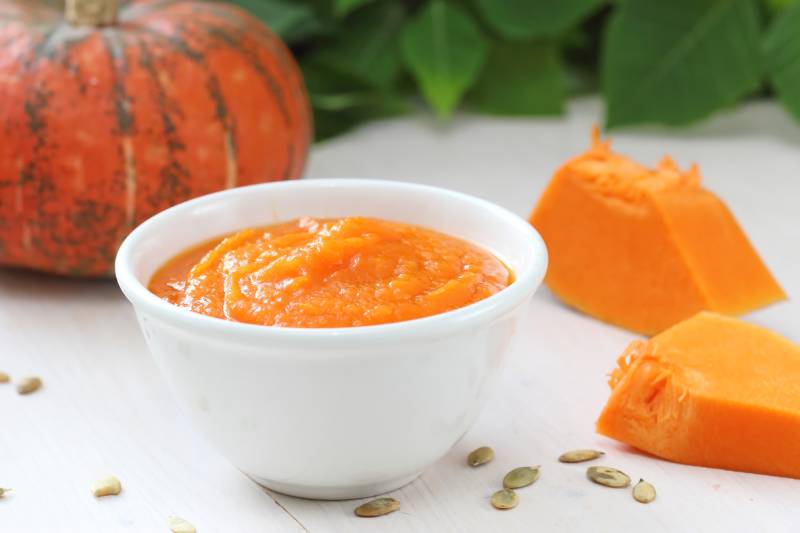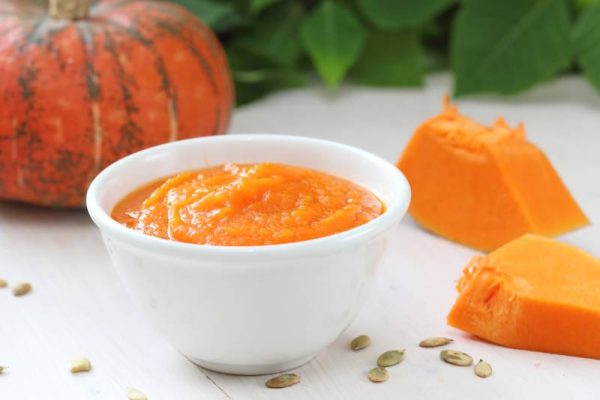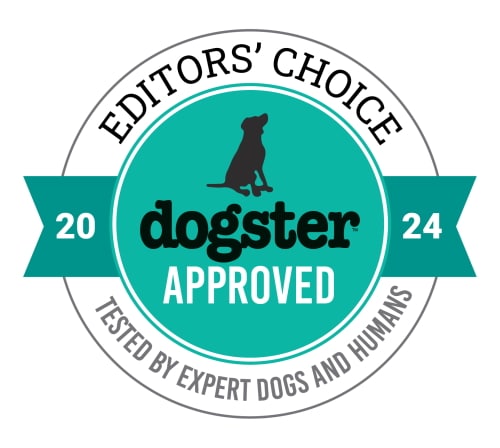Pumpkin is a staple vegetable, especially during autumn, when it even becomes a symbol for the season and we all proudly sport our pumpkin-themed sweaters and show off our pumpkin carving skills. A lot of us get our dogs involved in the festivities too, but not many realize that pumpkin can be included in your dog’s diet.
Pumpkin is versatile; it can be prepared as a sweet or savory dish, and there are many great ways to prepare it. Your dog will likely love the taste, and better yet, they will reap all its health benefits too.
Before You Start
Before you rush into the kitchen, there are some things to know about preparing and cooking pumpkin for your pal. It will be helpful to know about its health benefits, if it’s better raw or cooked, what parts of the pumpkin are suitable, how much your dog can eat, and some great pumpkin recipes.
It is also important to check if your dog enjoys the taste of pumpkin before you prepare a bunch. If your dog isn’t too keen, you could also try mixing a little puree with its food, sprinkling pumpkin flour over the food, or baking some delicious and healthy treats.
Benefits of Pumpkin in a Dogs Diet
Pumpkin is rich in vitamins and minerals, such as vitamins A, C, and E, as well as potassium and iron. Its fiber content is also great for your dog’s digestion. It can bulk up your dog’s stools to minimize diarrhea. Pumpkin is also a source of prebiotics to encourage the growth of beneficial bacteria in the digestive system.
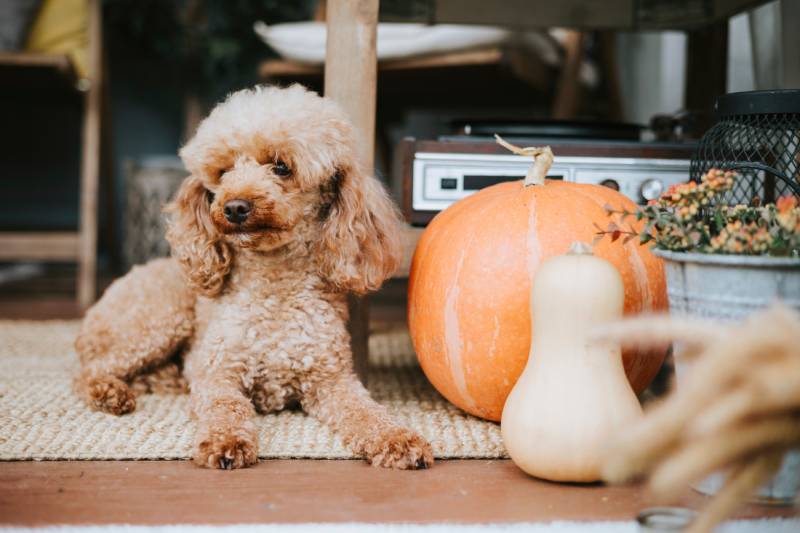
Is It Better Raw or Cooked?
Dogs can eat pumpkins raw or cooked, but it will depend on your dog’s preference. If you are introducing pumpkin to your dog’s diet, you can offer it a taste of both to see which it likes best. Even though raw pumpkin is safe, the pulp may be hard to digest, so it is preferred to serve it cooked. Raw pumpkin has an increased risk of becoming a choking hazard. Furthermore, cooking it improves the taste, and there is a higher chance that your dog will enjoy and appreciate it.
What About Pumpkin Seeds and Skin?
It may surprise you that pumpkin is considered a fruit rather than a vegetable because of its sweet taste and because it is full of seeds. Raw, organic seeds are safe for your dog, so you can sprinkle some ground-up seeds on top of their food or use them in doggy treats. They can even be roasted and enjoyed on their own as a treat.
The skin of the pumpkin is non-toxic, but it is pretty tough, which makes it hard to digest. In addition, it’s likely your pup won’t enjoy the taste. It’s best to remove the rind and only serve the flesh. The pumpkin’s rind will be a great addition to your compost heap.
How Much Pumpkin Can I Feed My Dog?
As with everything you feed your dog, pumpkin should be served in moderation. Even though it has many health benefits, too much pumpkin can have harmful effects.
Depending on your dog’s size, use ½ to 4 teaspoons of pumpkin in each meal. To avoid adding too much fiber, start with a small portion and gradually increase it. Always consult a veterinarian if you are unsure how much pumpkin to add to your dog’s diet.
PangoVet. It’s an online service where you can <b>talk to a vet online</b> and get the personalized advice you need for your pet — all at an affordable price!
</p>
<div class="su-button-center"><a href=https://www.dogster.com/dog-nutrition/"https://pangovet.com?utm_source=dogster&utm_medium=article&utm_campaign=dog-nutrition%22 class="su-button su-button-style-default" style="color:#FFFFFF;background-color:#FF6600;border-color:#cc5200;border-radius:9px;-moz-border-radius:9px;-webkit-border-radius:9px" target="_blank" rel="nofollow"><span style="color:#FFFFFF;padding:0px 24px;font-size:18px;line-height:36px;border-color:#ff944d;border-radius:9px;-moz-border-radius:9px;-webkit-border-radius:9px;text-shadow:none;-moz-text-shadow:none;-webkit-text-shadow:none"> Click to Speak With a Vet</span></a></div></div></div>"}" data-sheets-userformat="{"2":513,"3":{"1":0},"12":0}" data-sheets-validation-definition="{"1":{"1":{"1":23,"2":[{"1":1,"3":{"1":{"1":[{"1":4,"6":1},{"1":1,"2":"="}]},"2":{"1":[{"1":2,"2":"="},{"1":3,"3":1}]},"3":"R1]S"},"4":[{"1":{"1":1,"2":21,"3":0,"4":1,"5":2236944,"6":"841046713"},"2":1}]}],"6":[{"1":{"2":{"1":2,"2":"🛡️ Flea & tick"}},"2":{"1":2,"2":676776},"3":{"1":2,"2":12574966}},{"1":{"2":{"1":2,"2":"❤️ Preventative wellness"}},"2":{"1":2,"2":676776},"3":{"1":2,"2":12574966}},{"1":{"2":{"1":2,"2":"⚠️ Urinary problems"}},"2":{"1":2,"2":676776},"3":{"1":2,"2":12574966}},{"1":{"2":{"1":2,"2":"👁️ Eye issues"}},"2":{"1":2,"2":676776},"3":{"1":2,"2":12574966}},{"1":{"2":{"1":2,"2":"🩺 Other"}},"2":{"1":2,"2":676776},"3":{"1":2,"2":12574966}},{"1":{"2":{"1":2,"2":"🍎 Ate or drank"}},"2":{"1":2,"2":676776},"3":{"1":2,"2":12574966}},{"1":{"2":{"1":2,"2":"🐕 Behavior & training"}},"2":{"1":2,"2":676776},"3":{"1":2,"2":12574966}},{"1":{"2":{"1":2,"2":"🤮 Vomiting"}},"2":{"1":2,"2":676776},"3":{"1":2,"2":12574966}}]},"2":{"1":{"1":[{"1":4,"6":0},{"1":4,"6":1},{"1":2,"3":"CONDITION_ONE_OF_RANGE","4":2},{"1":1,"2":"="}]},"3":"R0]R1]FCONDITION_ONE_OF_RANGE:2]S"},"3":[{"1":{"1":0,"2":1,"3":0,"4":1,"5":1118464},"2":0},{"1":{"1":1,"2":21,"3":0,"4":1,"5":2236944,"6":"841046713"},"2":1}]},"2":"","3":1,"4":1,"6":0}" data-sheets-validation-id="0"> If you need to speak with a vet but can’t get to one, head over to PangoVet. It’s an online service where you can talk to a vet online and get the personalized advice you need for your pet — all at an affordable price!

How to Cook Pumpkin for Dogs
Pumpkin is versatile and can be cooked and prepared in various ways.
- Halve your pumpkin and remove the seeds and pulp.
- Peel and cut the pumpkin into smaller pieces and place them in a steamer. If you do not own a steamer, place a colander over a pot of water and put a lid on top.
- Steaming should take approximately 20 minutes, but it’s ready when it’s soft and tender.
- Preheat your oven to 350°F.
- Divide your pumpkin into quarters
- Scoop the seeds and pulp out of the pumpkin.
- Place the pumpkin in an oven-proof dish and bake in the oven for approximately 45 minutes.
- Halve your pumpkin and remove the seeds and pulp.
- Peel and cut the pumpkin into smaller pieces.
- Place the pumpkin pieces into a pot of water so that they are covered.
- Boil the pumpkin for approximately 25 minutes.
Once you have prepared your pumpkin with whichever method you choose, use a fork or toothpick to check that it is soft and tender and allow it to cool down. You can then freeze your pumpkin, blend it, or bake it into a dog-friendly treat.
Pumpkin Recipes
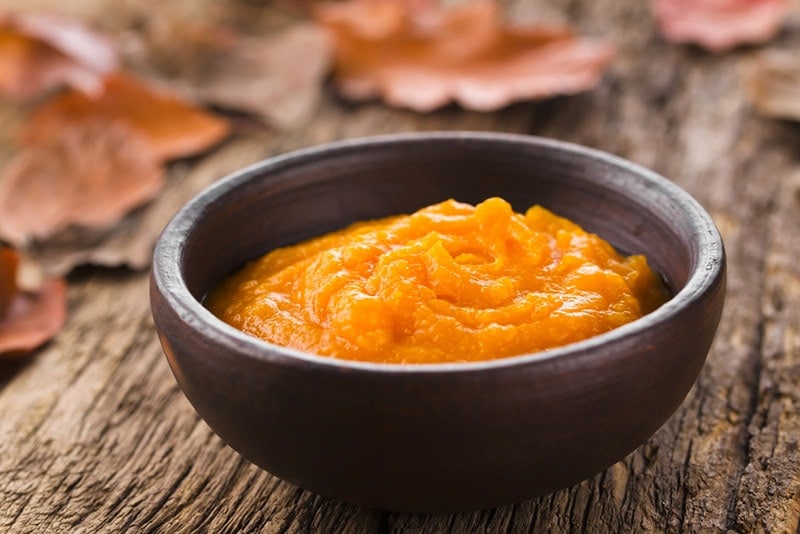
Pumpkin Puree
Pumpkin puree is the easiest recipe to prepare and can be served with your dog’s food, on its own, added to other recipes, or even frozen for later. All you need for this recipe is the pumpkin! You can prepare it using the previous methods and toss it into a blender with some water.
- Cut any large pumpkin pieces into smaller pieces for easier blending.
- Add water gradually so that you can get the right consistency.
- Store the puree in 1 cup servings for later use.
Summary
There are some great health benefits to feeding your dog pumpkin. It is a versatile ingredient that can be steamed, baked, or boiled, added to your dog’s meal, served alone, or baked into some tasty treats. The best method is to prepare a puree to freeze and store for later use. Don’t leave out the seeds either; they also have great benefits. They can easily be roasted and sprinkled over your dog’s food. Feeding your dog a healthy snack has never been this easy!
Featured Image Credit: Gamzova Olga, Shutterstock

